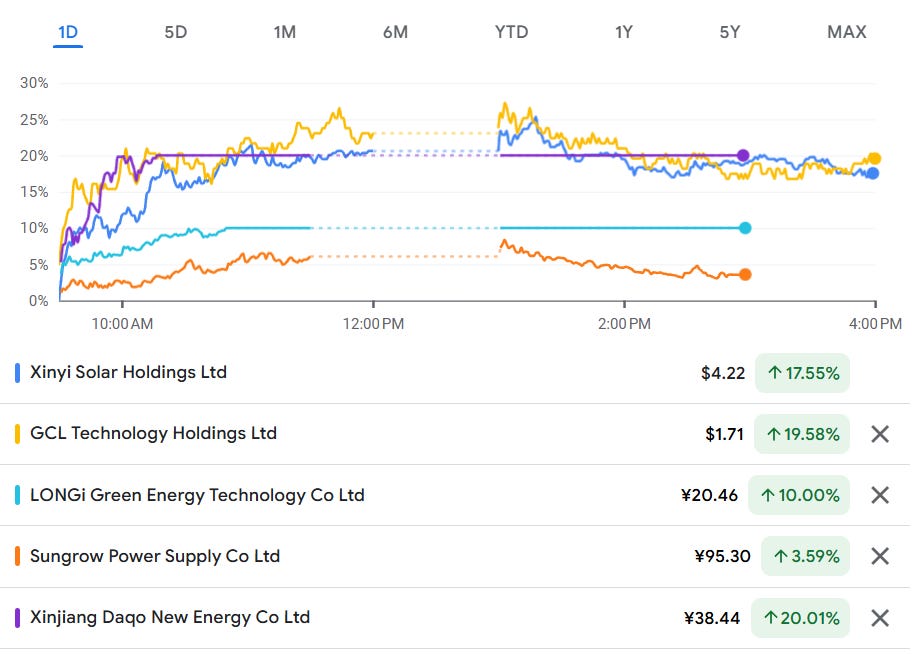Growth Dragons Weekly: 800 Billion Yuan Funding Unleashed For Stocks, Wind and Solar Stocks Jumped 10%, HKEX and Ping An Reported Growth
What happened in China this week:
China Launches 1.1 Trillion Yuan Funding Facilities to Bolster Stock Market
Wind and Solar Energy Stocks Surge Over 10% as Price Wars End
Ping An Reports 36% Profit Surge
HKEX Sees IPO Returns and Stock Trading Volume Rise by 23%
Rise of Autonomous Driving: Pony.ai and WeRide File for U.S. IPO
#1 China Launches 800 Billion Yuan Funding Facilities to Bolster Stock Market
On Friday, China’s central bank, the People’s Bank of China (PBOC), introduced two funding schemes aimed at injecting up to 800 billion yuan ($112.38 billion) into the stock market. These policy tools are intended to promote the "steady development" of capital markets and support liquidity amid market volatility.
The first scheme is a swap facility, initially valued at 500 billion yuan, which enables brokerages, asset managers, and insurers to access liquidity from the central bank by pledging assets as collateral. This liquidity can be directed towards stock purchases, ensuring smoother market operations. So far, 20 companies, including China International Capital Corp (CICC), Citic Securities, China Asset Management, and E Fund Management, have been approved to participate, with initial applications for the swap facility already exceeding 200 billion yuan—indicating strong demand.
Acting as a “market stabilizer,” the swap scheme allows financial institutions to access liquidity without having to sell shares during downturns, thereby avoiding additional downward pressure on stock prices. Eligible collateral includes bonds, stock exchange-traded funds (ETFs), and shares in CSI300 Index constituents, which can be exchanged for liquid assets like treasury bonds and central bank bills.
The PBOC also launched a re-lending program, initially valued at 300 billion yuan, to further support stock market activity. Through this facility, financial institutions can borrow directly from the central bank at a one-year interest rate of 1.75% to finance share purchases. Listed companies and their major shareholders can borrow from participating banks—at rates capped at 2.25%—for share buybacks or stock purchases. This policy provides institutions with additional leverage for market investments, which is typically restricted to mitigate risk.
The re-lending facility, open to 21 eligible financial institutions including policy and commercial banks, allows quarterly applications. By enabling companies and shareholders to increase shareholdings without needing market sales for liquidity, this program provides an added layer of stability during volatile periods.
Collectively, these initiatives demonstrate a strong commitment by the Chinese government to stabilize the stock market. However, expectations of a sharp rally should be tempered. The scale of these policies is relatively modest, accounting for less than 1% of the total Chinese stock market. Furthermore, substantial economic improvements will be necessary to solidify confidence in a sustained recovery.
#2 Wind and Solar Energy Stocks Surge Over 10% as Price Wars End
China's top wind-turbine and solar manufacturers have agreed to end a prolonged price war, aiming to address profitability concerns in the renewable energy sector. Despite China's leadership in global wind and solar capacity expansion, fierce price competition has pressured margins, pushing companies toward more sustainable practices.
Twelve major wind-turbine manufacturers, including Goldwind Science & Technology, Envision Energy, Windey Energy Technology Group, Ming Yang Smart Energy Group, and Sany Renewable Energy, have signed a pact to end undercutting and promote fair competition. This agreement aims to prevent harmful price-cutting and defamation campaigns against competitors. It also underscores the importance of legal pricing, disciplined strategies, and the establishment of self-regulation measures within the industry. Following this truce, shares in wind energy companies surged over 10% last week.
In the solar sector, there are speculations that Beijing will soon roll out regulations for the photovoltaic (PV) manufacturing industry. These potential policies would address the persistent oversupply and curb price undercutting, both of which have undermined the sector’s profitability. On Friday, solar stocks surged, with Daqo New Energy up 20%.
China remains a global leader in renewable energy. In 2023, the country added 76 gigawatts (GW) of wind capacity—66% of the world’s total—and accounted for over 60% of the world’s 425 GW solar PV capacity, according to the International Energy Agency (IEA). These regulatory shifts and the end of price wars could consolidate market share further for China's renewable energy players.





